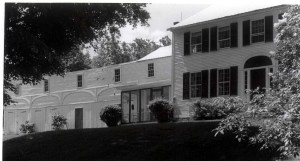NORWAY — A historic house on Patch Mountain Road destroyed by fire Wednesday was once owned by the founder of the Boston Herald and may have been a stopping place for Henry David Thoreau.
“It was a beautiful home. What a shame. What a shame,” said Paris Fire Department Chief Brad Frost, who returned to the site of the historic Jonathan Swift Inn on Thursday afternoon in the neighborhood where he grew up.
Fire departments from a dozen towns battled the flames that raced through the six-bedroom home at the intersection with Morse Road.
Norway Fire Chief Dennis Yates said a cooking accident ignited the fire that destroyed the 2 1/2-story farmhouse and attached barn that stretched an estimated 100 feet across a small knoll.
Local pediatrician Dr. Jill Gabrielsen, her husband Edward and their children, Eva and Eli, lived in the house. One unidentified male escaped the fire unharmed. The family dog was believed to be in the house at the time of the fire. The family was unable to recover anything, Frost said.
All that was left by Thursday morning was a pile of debris, old flagstone steps leading up the knoll to where the house stood and a tall, century-old maple tree that was seared from the flames.
Frost, who grew up across the street, said he remembered the house when it was owned by a professor Hussey. A small gas station was on the hill behind the house, a well with pull-hand bucket was across the street, he said. But most of all, Frost said he remembered the beautiful woodwork and fireplaces in the home.
“It was beautiful,” he said.
Frost, like many in the area who slowly drove by the remains on Thursday, was mourning the loss of what has been called a “landmark” in Norway.
“Aside from the tragedy of the family losing everything, the Swift property still had its original exterior appearance and stood at that corner for 200 years. This particular fire means another piece of Norway’s history is gone,” said Susan Denison, president of the Norway Historical Society.
The house was built as an inn, because what are now the Norway Center and Patch Mountain roads was the major road traveling from the south, from Gray to Bethel and beyond in the 1800s, Denison said.
According to a 1936 report in the Lewiston Evening Journal, Jonathan Swift built the structure in 1829 on a land grant he took over at the close of the Revolutionary War. He built it with enough rooms to house transient guests and a long coach house for horses and carriages.
The house, which became the summer home of Boston Herald founder John A. French in the mid 1800s, displayed magnificent woodwork with hand-hewn oak beams measuring eight inches square and wainscoting and paneling from single pieces of timber that ran the entire length of a room. Ceilings were plastered with split boards and wrought iron door handles peppered throughout the house. White mantels, brass fittings and six fireplaces graced the home.
It was reported that the wainscoting was on exhibition at the Chicago World’s Fair in the 1890s and that 19th century American author and naturalist Henry David Thoreau may have slept at the inn.
The home on Swift’s Corner, overlooking Pennesseewassee Lake and snuggled into the foreground of Noyes Mountain, was considered so magnificent that it became the topic for a 1949 article in the Christian Science Monitor newspaper.
“It is a sightly place, as the old folks have a way of saying,” according to the Lewiston Evening Journal in 1936.




Comments are no longer available on this story